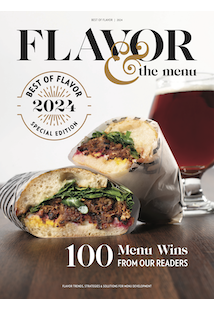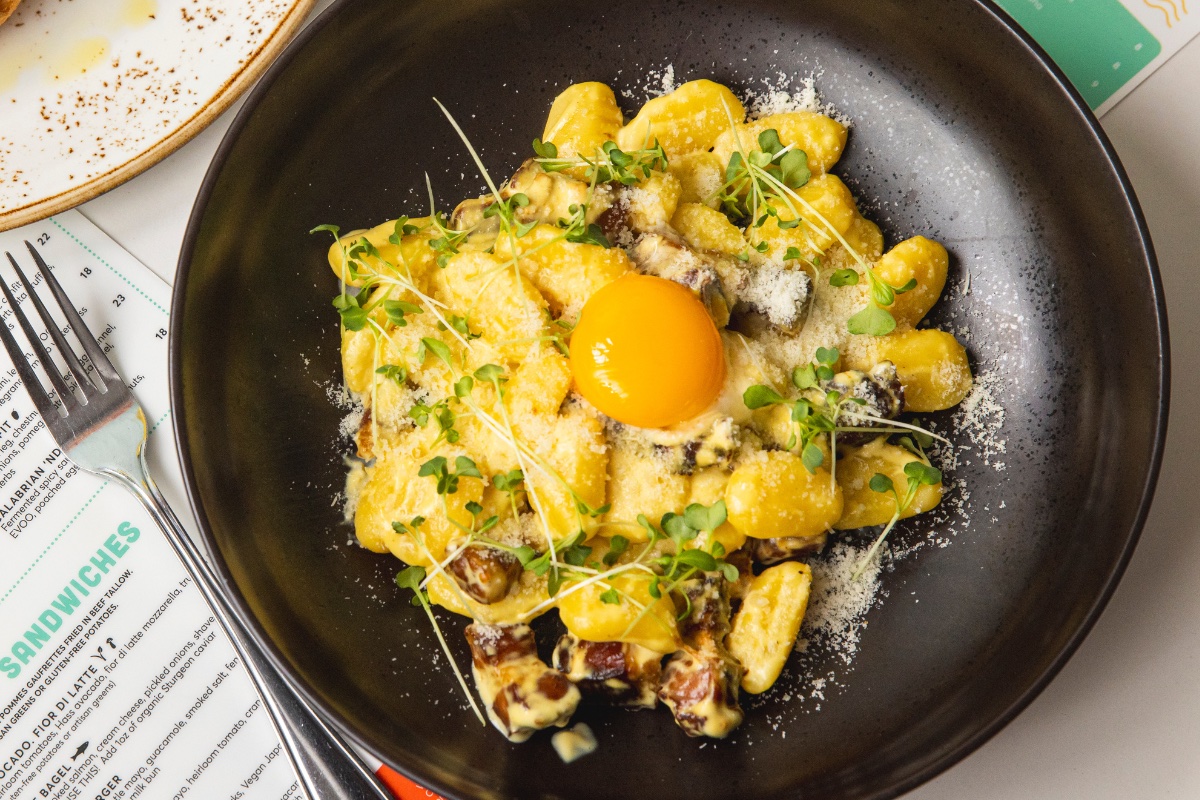
5 Pasta Trends for 2025
From breakfast renditions to exciting new textures
5 Pasta Trends for 2025
From breakfast renditions to exciting new textures
By Leigh Kunkel
October 15, 2024
By Leigh Kunkel
October 15, 2024
The beautiful thing about pasta is its seemingly impossible marriage of simplicity and complexity. Its relatively neutral flavor makes it the perfect base for other ingredients to shine, while providing infinite opportunities for variation through texture, shape and technique. And despite a millennium of history, pasta still offers room for innovation: a new shape hit the market as recently as 2021. Maybe that’s why people everywhere—from high-end chefs to social media home cooks—are pushing pasta to places it’s never been before.
Noodling on how to make your pasta dishes pack a punch? Here are a few trends we’re seeing in the space to inspire your next carb-based creation.
1
Breakfast Pasta
Combining the most important meal of the day with a comfort food favorite is a recipe for tasty success. “There are a lot of ways you can incorporate pasta into breakfast and brunch menus if you just look at it with a bit of innovation,” says Chef Ian Ramirez, founder and co-owner of Mad Honey Culinary Studio. “For example, pasta would pair well with a dish like shakshuka. Or if you look at a classic sausage gravy, a few minor adjustments and you could be close to a cacio e pepe meat sauce tossed with pasta and topped with a fried egg.” For an especially upscale offering, he suggests a crab-stuffed ravioli eggs Benedict served with grilled asparagus.
Ramirez is well-acquainted with the pasta-for-breakfast possibilities. When he was growing up, his family would make Sunday morning frittatas from the previous night’s leftover pasta. “This was more of a brunch dish for us since we would cook it before church. Then upon returning, we would eat it at room temp with tomato sauce, salad greens, fresh fruit and sliced meats,” he recalls. “It was just a thing that we did, but it always had pasta of some sort in it.”
Breakfast chain Snooze A.M. Eatery has been experimenting with a few different morning pasta dishes. Last year’s fall specials included a Carbonara Breakfast Pasta, which takes the classic Italian dish and gives it a breakfast twist by adding soft-scrambled eggs, braised habanero pork belly and brioche bread crumbs. Canadian chain OEB Breakfast Co., which has expanded into California and Arizona, features a Gnocchi Carbonara on its permanent menu. The luscious dish features double-smoked bacon, brown butter hollandaise, Grana Padano, cracked black pepper and raw yolk with a delicate garnish of petite watercress.
2
New Takes on Texture
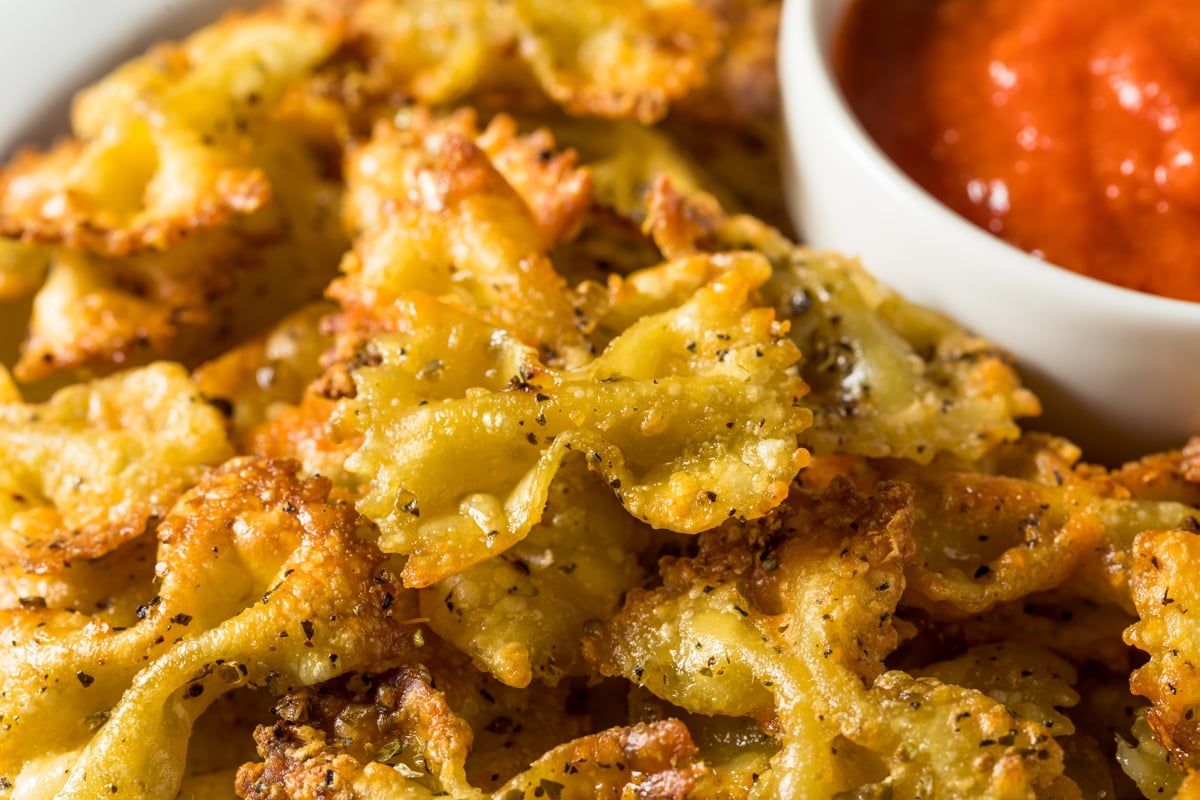
Pasta finds its way onto the appetizer menu when it’s seasoned and baked into flavorful chips that can be dipped in everything from marinara sauce and pesto to spinach-and-artichoke dip.
A new generation of pasta dishes is going beyond al dente. “Chewy textures have long been adored by Asian palates,” says Chef Henry Hill, founder of Hill’s Research Kitchen, who employs the term “chewdente” to describe the new trend. For example, in Singapore, St. Marc Café offers a number of traditional pasta dishes, including Bolognese and aglio e olio, that are served with Japanese-style mochi noodles that provide extra bounce and chew. For now, the boba craze is providing an entry point for this texture into the West, Hill reports.
On the other end of the texture spectrum, some purveyors are leaning into pasta’s crunchy side, as evidenced by a handful of CPG brands specializing in pasta chips. Restaurants are pursuing this trend, too. Louisiana micro-chain The Chimes serves spicy, crunchy bowtie pasta chips that are perfect for scooping into a creamy spinach-and-artichoke dip. “It’s a really cool way to cross-utilize a product as a bar snack or a crispy garnish on just about anything,” Hill says.
3
Third-Culture Inspiration
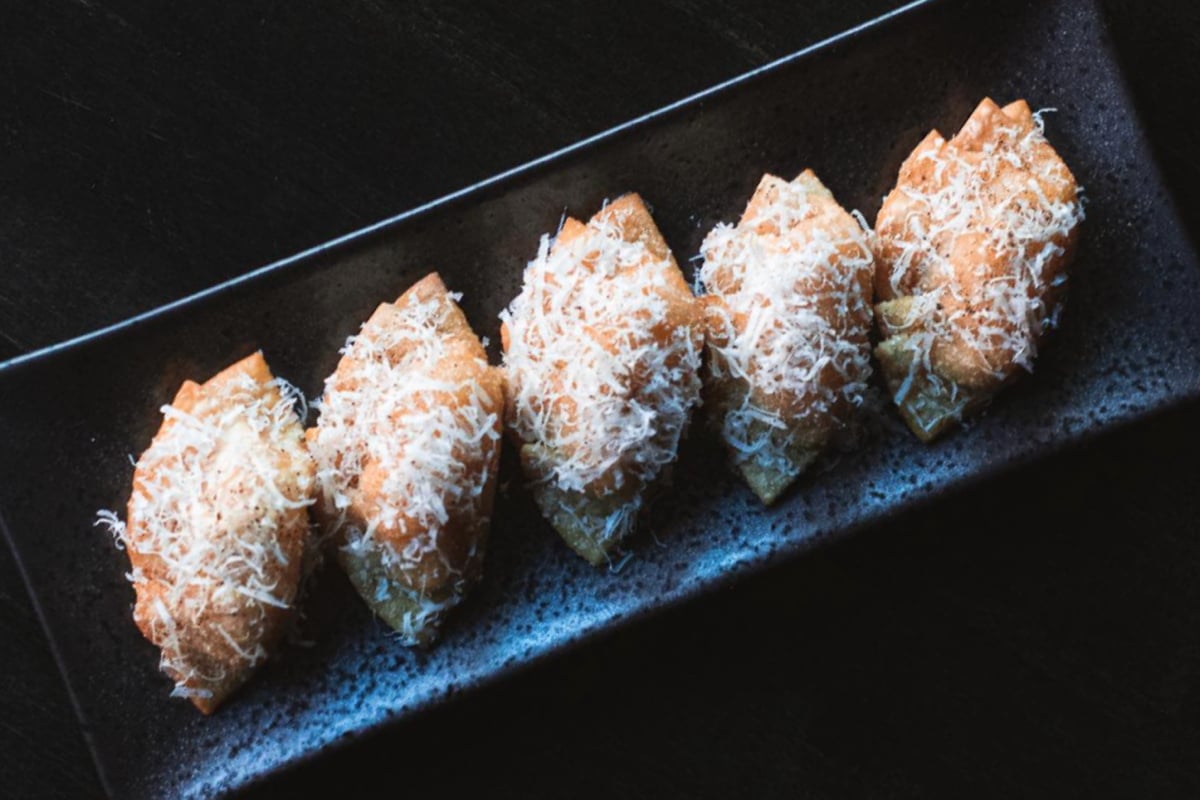 Photo Credit: Pasta Ramen
Photo Credit: Pasta Ramen Specializing in Italian-Japanese fare, PastaRamen serves Cacio e Pepe Gyoza, which reformats the iconic Italian pasta as a dumpling filled with Parmesan and pepper.
Fusing pasta with non-Italian flavors and ingredients is perfect for those looking to inject some creativity into their menus. “For Gen Z in particular, ‘authenticity’ is a moving target, constantly evolving to reflect their own diversity and identity,” says Jane Hurh, senior strategist at food and beverage innovation agency The Culinary Edge. “Pasta, like its classic Americana counterparts of pizzas and burgers, is not immune to this trend of third-culture mash-ups.”
In New Orleans, the new pop-up concept Señor Gabagool specializes in Mex-Italian fare, with offerings like Elote Pasta Salad (rotini, Mexican street corn, mayo and chiles) and Tres Leches Cannoli. For the best-selling Birria Pasta, bowtie noodles are cooked in a birria sauce along with braised beef and a bit of beef fat for umami-rich flavor; the dish is finished with queso fresco, onion and fresh cilantro.
Other menu developers are exploring more established fusions, particularly Wafu Italian, an intersection of Japanese and Italian cooking. The style, which has been popular in Asia for years, is catching on in the United States. “Japan has such a strong noodle culture already and is known for exceptional execution of Italian cuisine,” Hill says. “I think that Japanese flavors are poised well at the moment as a way to add some excitement to a pasta program looking for the edge of innovation.”
Under the direction of Chef Robbie Felice (arguably the master of all things Wafu), PastaRamen in Montclair, N.J., offers dishes like Cacio e Pepe Gyoza, which transforms a pasta dish into a bite-size dumpling. The Mochi Ramen Carbonara Tsukemen applies Japanese flavor to an Italian staple, with egg yolk, togarashi, sesame and lemon. Similarly, the on-trend Ramen Napolitan, aka Japanese Ketchup Spaghetti, brings Far East flavor to a Western cuisine.
4
Less-Is-More Comfort
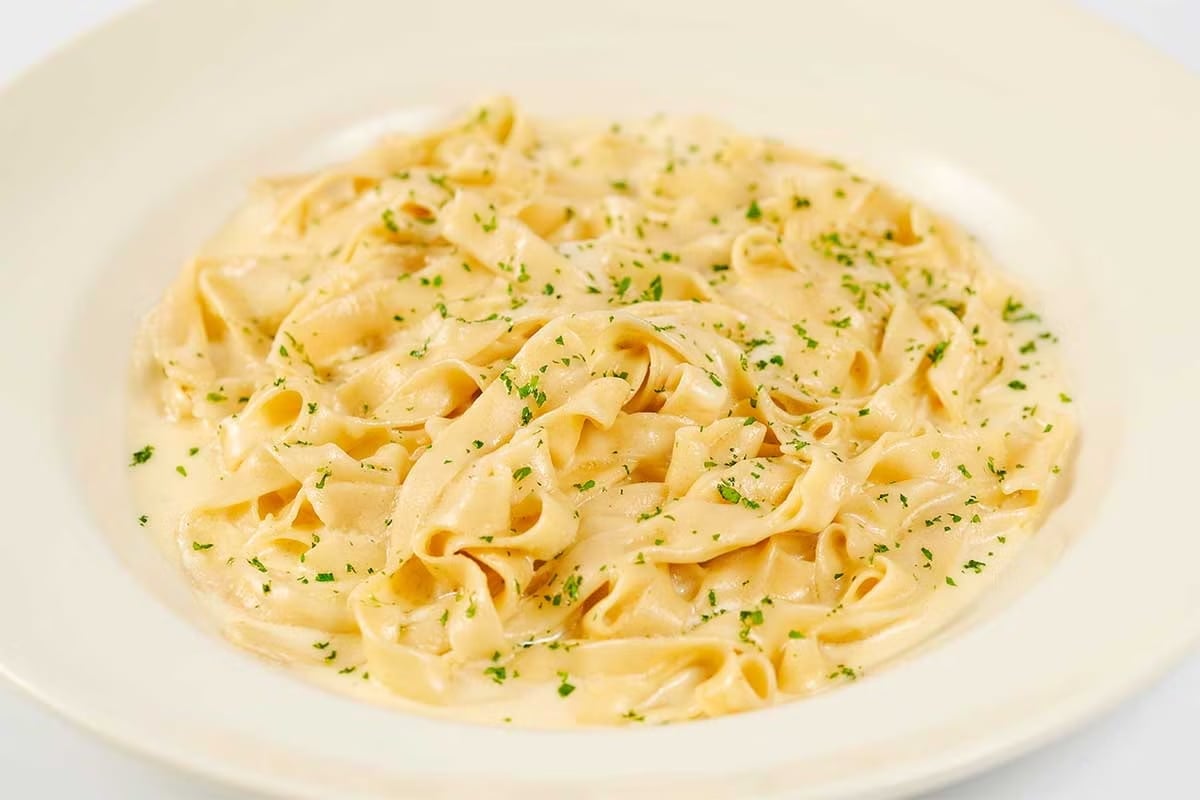 Photo Credit: The Cheesecake Factory
Photo Credit: The Cheesecake Factory Despite its extensive menu and long history, The Cheesecake Factory’s most popular dish remains its simple yet craveable Fettuccine Alfredo.
Though chefs and consumers might seek out nontraditional takes on pasta, the simplest, most familiar dishes remain favorites—and some might even be poised for a resurgence. “As we’ve seen across menus across categories, nostalgia is on the rise, with diners turning to memories of a simpler time amid a chaotic reality,” explains The Culinary Edge’s Hurh. “The growing interest in nostalgic comfort foods gives traditional recipes new relevance, and pasta is uniquely poised to deliver on the warmth and familiarity that we crave.” She offers New York institution Carbone as an example: Its Spicy Rigatoni Vodka, while straightforward, has carved a legacy for itself and the restaurant.
Several of the largest full-service chains in the U.S. fall under the Italian category, such as Olive Garden, Maggiano’s Little Italy and Carrabba’s Italian Grill. Even at restaurants that don’t specialize in Italian cuisine, pasta dishes can be top sellers. The Cheesecake Factory’s Fettuccine Alfredo remains its most popular dish nearly five decades into its operation, Hurh points out—which is quite the feat, considering the restaurant’s encyclopedia-length menu. In embracing simple dishes, menu developers should prioritize high-caliber ingredients. After all, the quality of individual components is most obvious in basic builds. “Tortello in Chicago elevates its deliciously uncomplicated Cacio e Pepe by leaning into ingredient quality and sourcing, calling out bucatini, imported aged pecorino, and fresh cracked black pepper to cue value, taste and expertise,” says Leslie Brian, strategy lead for The Culinary Edge.
5
Start Shapeshifting
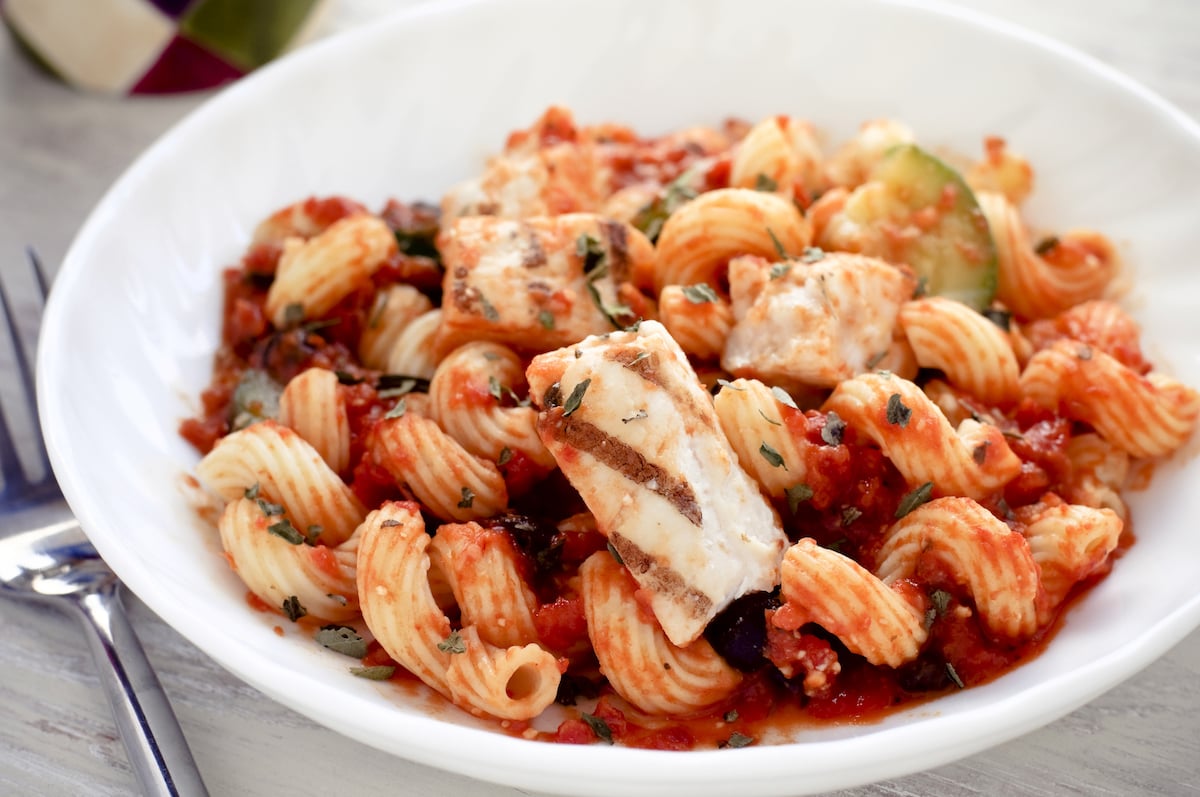 Photo Credit: Lyfe Kitchen
Photo Credit: Lyfe Kitchen Cellentani, also known as cavatappi, brings both visual and flavor intrigue—its iconic corkscrew shape is eye-catching while its hollow center provides extra surface area to soak up sauce.
While pasta’s craveability is self-evident, its visual appeal can be hit or miss. For every pasta dish that is carefully plated to highlight fresh ingredients, there’s another that is chaotic. The resurgence of heritage shapes—and the emergence of new ones—have been driven in part by their aesthetics. “Different sizes, shapes and lengths of pasta have become an innovation playground,” Brian says. “Innovative shapes and sizes add visual appeal that’s perfect for the ‘phone eats first’ generation.”
To drum up more interest around these varieties, restaurants can yoke the names of dishes to the pasta shapes themselves, Brian adds. At Grassa in Portland, Ore., dishes are named by shape alone, with the other ingredients appearing in a longer description. For example, the Campanelle is adorned with baked feta, blistered cherry tomatoes, black olives and herbs, while the Pasta alla Chitarra is tossed with hazelnut pesto, zucchini and whipped ricotta. In Brooklyn, N.Y., Forma Pasta Factory takes a similar approach, with dishes spotlighting their novel shapes in presentation and name. The Mafaldine Scampi features the ribbon-like pasta—rather than the typical spaghetti or linguine—along with sautéed shrimp, white wine-lemon butter sauce, chile flakes and garlic bread crumbs. The Gemelli Pesto breaks the spiral shape out of its usual casserole format and lets it shine with basil pine nut pesto, confit cherry tomatoes and Parmigiano Reggiano.
Beyond the visual and experiential elements, subbing in different shapes can also influence flavor. Thick noodles like tagliatelle and pappardelle hold up well in heavy sauces, slender varietals like capellini are best paired with lighter fare, and spirals grab onto oil-based sauces. Hollow, tubular noodles like cavatappi, bucatini and ditalini are exceptional at soaking in flavors. “When it comes to pasta being a sauce carrier, tubular pasta usually does a great job of fitting the bill. It’s also great in hot or cold applications,” says Mad Honey’s Ramirez. “I also feel that there are a lot of creative plating opportunities with this shape of pasta.”
Long or short, saucy or plain, pasta inspiration can come from just about anywhere. Consider surprising flavor profiles, plays on texture and even new occasions to serve your dish—diners will eat it up. “The possibilities are endless,” Henry Hill says. “At the end of the day, the world loves noodles.”
The beautiful thing about pasta is its seemingly impossible marriage of simplicity and complexity. Its relatively neutral flavor makes it the perfect base for other ingredients to shine, while providing infinite opportunities for variation through texture, shape and technique. And despite a millennium of history, pasta still offers room for innovation: a new shape hit the market as recently as 2021. Maybe that’s why people everywhere—from high-end chefs to social media home cooks—are pushing pasta to places it’s never been before.
Noodling on how to make your pasta dishes pack a punch? Here are a few trends we’re seeing in the space to inspire your next carb-based creation.
1
Breakfast Pasta
Combining the most important meal of the day with a comfort food favorite is a recipe for tasty success. “There are a lot of ways you can incorporate pasta into breakfast and brunch menus if you just look at it with a bit of innovation,” says Chef Ian Ramirez, founder and co-owner of Mad Honey Culinary Studio. “For example, pasta would pair well with a dish like shakshuka. Or if you look at a classic sausage gravy, a few minor adjustments and you could be close to a cacio e pepe meat sauce tossed with pasta and topped with a fried egg. For an especially upscale offering, he suggests a crab-stuffed ravioli eggs Benedict served with grilled asparagus.
Ramirez is well-acquainted with the pasta-for-breakfast possibilities. When he was growing up, his family would make Sunday morning frittatas from the previous night’s leftover pasta. “This was more of a brunch dish for us since we would cook it before church. Then upon returning, we would eat it at room temp with tomato sauce, salad greens, fresh fruit and sliced meats,” he recalls. “It was just a thing that we did, but it always had pasta of some sort in it.”
Breakfast chain Snooze A.M. Eatery has been experimenting with a few different morning pasta dishes. Last year’s fall specials included a Carbonara Breakfast Pasta, which takes the classic Italian dish and gives it a breakfast twist by adding soft-scrambled eggs, braised habanero pork belly and brioche bread crumbs. Canadian chain OEB Breakfast Co., which has expanded into California and Arizona, features a Gnocchi Carbonara on its permanent menu. The luscious dish features double-smoked bacon, brown butter hollandaise, Grana Padano, cracked black pepper and raw yolk with a delicate garnish of petite watercress..
2
New Takes on Texture

Pasta finds its way onto the appetizer menu when it’s seasoned and baked into flavorful chips that can be dipped in everything from marinara sauce and pesto to spinach-and-artichoke dip.
A new generation of pasta dishes is going beyond al dente. “Chewy textures have long been adored by Asian palates,” says Chef Henry Hill, founder of Hill’s Research Kitchen, who employs the term “chewdente” to describe the new trend. For example, in Singapore, St. Marc Café offers a number of traditional pasta dishes, including Bolognese and aglio e olio, that are served with Japanese-style mochi noodles that provide extra bounce and chew. For now, the boba craze is providing an entry point for this texture into the West, Hill reports.
On the other end of the texture spectrum, some purveyors are leaning into pasta’s crunchy side, as evidenced by a handful of CPG brands specializing in pasta chips. Restaurants are pursuing this trend, too. Louisiana micro-chain The Chimes serves spicy, crunchy bowtie pasta chips that are perfect for scooping into a creamy spinach-and-artichoke dip. “It’s a really cool way to cross-utilize a product as a bar snack or a crispy garnish on just about anything,” Hill says.
3
Third-Culture Inspiration
 Photo Credit: Pasta Ramen
Photo Credit: Pasta Ramen Specializing in Italian-Japanese fare, PastaRamen serves Cacio e Pepe Gyoza, which reformats the iconic Italian pasta as a dumpling filled with Parmesan and pepper.
In New Orleans, the new pop-up concept Señor Gabagool specializes in Mex-Italian fare, with offerings like Elote Pasta Salad (rotini, Mexican street corn, mayo and chiles) and Tres Leches Cannoli. For the best-selling Birria Pasta, bowtie noodles are cooked in a birria sauce along with braised beef and a bit of beef fat for umami-rich flavor; the dish is finished with queso fresco, onion and fresh cilantro.
Other menu developers are exploring more established fusions, particularly Wafu Italian, an intersection of Japanese and Italian cooking. The style, which has been popular in Asia for years, is catching on in the United States. “Japan has such a strong noodle culture already and is known for exceptional execution of Italian cuisine,” Hill says. “I think that Japanese flavors are poised well at the moment as a way to add some excitement to a pasta program looking for the edge of innovation.”
Under the direction of Chef Robbie Felice (arguably the master of all things Wafu), PastaRamen in Montclair, N.J., offers dishes like Cacio e Pepe Gyoza, which transforms a pasta dish into a bite-size dumpling. The Mochi Ramen Carbonara Tsukemen applies Japanese flavor to an Italian staple, with egg yolk, togarashi, sesame and lemon. Similarly, the on-trend Ramen Napolitan, aka Japanese Ketchup Spaghetti, brings Far East flavor to a Western cuisine.
4
Less-Is-More Comfort
 Photo Credit: The Cheesecake Factory
Photo Credit: The Cheesecake Factory Despite its extensive menu and long history, The Cheesecake Factory’s most popular dish remains its simple yet craveable Fettuccine Alfredo.
Several of the largest full-service chains in the U.S. fall under the Italian category, such as Olive Garden, Maggiano’s Little Italy and Carrabba’s Italian Grill. Even at restaurants that don’t specialize in Italian cuisine, pasta dishes can be top sellers. The Cheesecake Factory’s Fettuccine Alfredo remains its most popular dish nearly five decades into its operation, Hurh points out—which is quite the feat, considering the restaurant’s encyclopedia-length menu.
In embracing simple dishes, menu developers should prioritize high-caliber ingredients. After all, the quality of individual components is most obvious in basic builds. “Tortello in Chicago elevates its deliciously uncomplicated Cacio e Pepe by leaning into ingredient quality and sourcing, calling out bucatini, imported aged pecorino, and fresh cracked black pepper to cue value, taste and expertise,” says Leslie Brian, strategy lead for The Culinary Edge.
5
Start Shapeshifting
 Photo Credit: Lyfe Kitchen
Photo Credit: Lyfe Kitchen Cellentani, also known as cavatappi, brings both visual and flavor intrigue—its iconic corkscrew shape is eye-catching while its hollow center provides extra surface area to soak up sauce.
To drum up more interest around these varieties, restaurants can yoke the names of dishes to the pasta shapes themselves, Brian adds. At Grassa in Portland, Ore., dishes are named by shape alone, with the other ingredients appearing in a longer description. For example, the Campanelle is adorned with baked feta, blistered cherry tomatoes, black olives and herbs, while the Pasta alla Chitarra is tossed with hazelnut pesto, zucchini and whipped ricotta. In Brooklyn, N.Y., Forma Pasta Factory takes a similar approach, with dishes spotlighting their novel shapes in presentation and name. The Mafaldine Scampi features the ribbon-like pasta—rather than the typical spaghetti or linguine—along with sautéed shrimp, white wine-lemon butter sauce, chile flakes and garlic bread crumbs. The Gemelli Pesto breaks the spiral shape out of its usual casserole format and lets it shine with basil pine nut pesto, confit cherry tomatoes and Parmigiano Reggiano.
Beyond the visual and experiential elements, subbing in different shapes can also influence flavor. Thick noodles like tagliatelle and pappardelle hold up well in heavy sauces, slender varietals like capellini are best paired with lighter fare, and spirals grab onto oil-based sauces. Hollow, tubular noodles like cavatappi, bucatini and ditalini are exceptional at soaking in flavors. “When it comes to pasta being a sauce carrier, tubular pasta usually does a great job of fitting the bill. It’s also great in hot or cold applications,” says Mad Honey’s Ramirez. “I also feel that there are a lot of creative plating opportunities with this shape of pasta.”
Long or short, saucy or plain, pasta inspiration can come from just about anywhere. Consider surprising flavor profiles, plays on texture and even new occasions to serve your dish—diners will eat it up. “The possibilities are endless,” Henry Hill says. “At the end of the day, the world loves noodles.”
About the Author
![]() Leigh Kunkel is a freelance journalist with more than a decade of restaurant industry experience as a server, bartender and sommelier. She has written about restaurant operations for B2B publications, as well as foodservice brands, including Beam Suntory and Dawn Foods. She specializes in covering flavor, ingredient and cuisine trends. Leigh has also covered the food and beverage world for a wide range of consumer outlets such as The New York Times, Eater and Vinepair.
Leigh Kunkel is a freelance journalist with more than a decade of restaurant industry experience as a server, bartender and sommelier. She has written about restaurant operations for B2B publications, as well as foodservice brands, including Beam Suntory and Dawn Foods. She specializes in covering flavor, ingredient and cuisine trends. Leigh has also covered the food and beverage world for a wide range of consumer outlets such as The New York Times, Eater and Vinepair.

